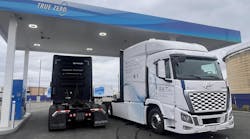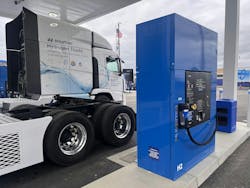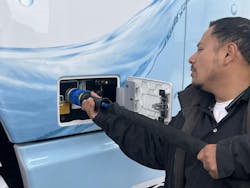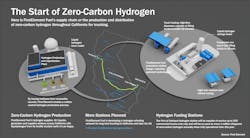OAKLAND, California—FirstElement Fuel is opening a hydrogen fueling station near the Port of Oakland. The company unveiled its plans at the soon-to-open fueling station, which it said would be North America's first public hydrogen fueling station.
Placing the facility near the Port of Oakland was strategic. Thousands of Class 8 trucks travel around the California Bay Area ports daily, and Eugene Litvinov, director of commercial vehicle and hydrogen business development at Hyundai Motor North America, said that, often, trucks working in port and drayage operations “are on their third and fourth, or maybe even fifth life cycle, meaning they're older models and much more heavily polluting; they're having to idle a lot as they wait for their loads.”
Therefore, it is estimated that operating just 30 hydrogen fuel cell trucks in drayage operations at the Port of Oakland would eliminate almost 50 million lb. of CO2, reduce nearly 2 million gallons of diesel, and eliminate 300,000 lb. of other pollutants, according to Litvinov.
Overcoming obstacles to hydrogen fuel adoption
Opening the station to the public helps solve the “chicken or the egg” equation with hydrogen-powered vehicles, which is: infrastructure versus vehicle availability.
Ten years ago, Dr. Shane Stephens, FirstElement founder and chief development officer, said there were three obstacles to hydrogen-powered vehicle adoption: development of fuel cell stacks, hydrogen tanks, and infrastructure.
“The car companies have pretty much gotten to the fuel cell stack and the tanks, and they've solved those issues. The last outstanding thing is the infrastructure,” Stephens said. “That's why we founded this company over 10 years ago to develop that network of commercial hydrogen stations and help overcome that chicken and egg challenge.”
See also: Renewable diesel could cut emissions for much less than electrification
Once the public station opens in May, it can support more than 200 Class 8 hydrogen-powered trucks daily, according to the hydrogen supply and fueling company. FirstElement anticipates supporting this many trucks through a refill time of about 10 minutes per truck—on par with the time it takes to refuel diesel Class 8 trucks. One fleet operating 30 Class 8 Hyundai Xcient hydrogen trucks in the area has already committed to fueling at the station.
FirstElement’s initial financing came from automotive companies and public agencies in California. It has since acquired additional private funding of more than $340 million and more than $150 million from state and regional agencies. The company also owns more than $25 million of upstream supply assets to support its pioneering efforts in developing hydrogen infrastructure.
"We never saw ourselves getting into [the hydrogen upstream supply] business, but frankly, the systems that were out there for delivery and distribution of hydrogen left us hanging out to dry,” Stephens said. “They were not sufficient to meet customer demands and our demands, and we had several fuel supply disruptions with some of the providers that were out there. So we actually invested in trailers and some upstream supply assets so that we can fill those gaps.”
In addition to its own supply chain developments, FirstElement also operates its True Zero Hydrogen Innovation Center, which conducts research and development and in-house fabrication. While FirstElement’s operations are robust today, the 10-year process to get there took trial and error.
The road to public hydrogen fueling
FirstElement has worked on bringing hydrogen fueling infrastructure to market for 10 years, developing three types of hydrogen refueling stations. The first generation of hydrogen refueling station, launched in 2015 and 2016, only provided 200 kg of hydrogen per day with one dispenser. The station was primarily used for hydrogen-powered passenger cars. The station was designed by FirstElement’s equipment supplier and supports gaseous hydrogen.
See also: Scaling up AVs for the commercial vehicle industry
“We quickly saw that these [first-generation] stations cannot meet up with consumer demand whenever the cars began to enter the marketplace,” Stephens explained. “We had long lines for customers, four or five cars deep, so the last car in line there is going to end up waiting 20 or 25 minutes to fill.”
See also: Hyzon helps fleet cover its bases before implementing hydrogen fuel cell EVs
Scaling hydrogen infrastructure
While the world’s first public hydrogen fueling station, capable of fueling heavy-duty vehicles, hasn’t officially opened, pilot refueling at the site has resulted in more than 200 demonstration fills on heavy-duty trucks. Within the last 30 days, the site has completed more than 50 fills with more than 2,000 kg of total hydrogen dispensed.
FirstElement plans for more hydrogen truck stops, with two currently in development. Each truck stop will also feature a fueling island for light- and medium-duty vehicles—all open to the public for commercial vehicle charging. Stephens said that developing these stations will help support the adoption of hydrogen-powered vehicles in the commercial market.







